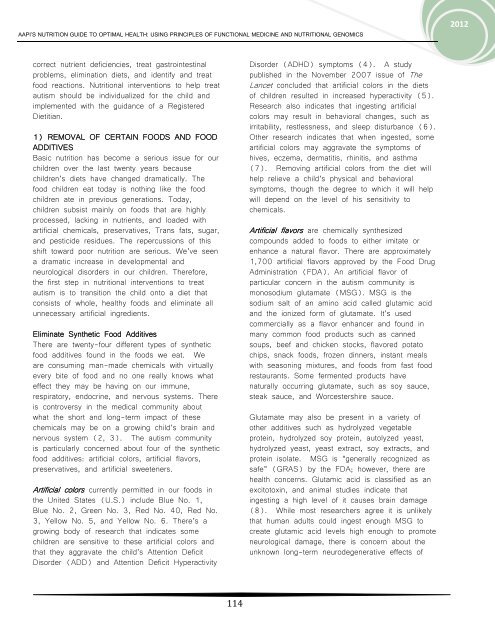functional medicine and nutritional genomics - American Association ...
functional medicine and nutritional genomics - American Association ...
functional medicine and nutritional genomics - American Association ...
Create successful ePaper yourself
Turn your PDF publications into a flip-book with our unique Google optimized e-Paper software.
AAPI’S NUTRITION GUIDE TO OPTIMAL HEALTH: USING PRINCIPLES OF FUNCTIONAL MEDICINE AND NUTRITIONAL GENOMICS<br />
correct nutrient deficiencies, treat gastrointestinal<br />
problems, elimination diets, <strong>and</strong> identify <strong>and</strong> treat<br />
food reactions. Nutritional interventions to help treat<br />
autism should be individualized for the child <strong>and</strong><br />
implemented with the guidance of a Registered<br />
Dietitian.<br />
1) REMOVAL OF CERTAIN FOODS AND FOOD<br />
ADDITIVES<br />
Basic nutrition has become a serious issue for our<br />
children over the last twenty years because<br />
children’s diets have changed dramatically. The<br />
food children eat today is nothing like the food<br />
children ate in previous generations. Today,<br />
children subsist mainly on foods that are highly<br />
processed, lacking in nutrients, <strong>and</strong> loaded with<br />
artificial chemicals, preservatives, Trans fats, sugar,<br />
<strong>and</strong> pesticide residues. The repercussions of this<br />
shift toward poor nutrition are serious. We’ve seen<br />
a dramatic increase in developmental <strong>and</strong><br />
neurological disorders in our children. Therefore,<br />
the first step in <strong>nutritional</strong> interventions to treat<br />
autism is to transition the child onto a diet that<br />
consists of whole, healthy foods <strong>and</strong> eliminate all<br />
unnecessary artificial ingredients.<br />
Eliminate Synthetic Food Additives<br />
There are twenty-four different types of synthetic<br />
food additives found in the foods we eat. We<br />
are consuming man-made chemicals with virtually<br />
every bite of food <strong>and</strong> no one really knows what<br />
effect they may be having on our immune,<br />
respiratory, endocrine, <strong>and</strong> nervous systems. There<br />
is controversy in the medical community about<br />
what the short <strong>and</strong> long-term impact of these<br />
chemicals may be on a growing child’s brain <strong>and</strong><br />
nervous system (2, 3). The autism community<br />
is particularly concerned about four of the synthetic<br />
food additives: artificial colors, artificial flavors,<br />
preservatives, <strong>and</strong> artificial sweeteners.<br />
Artificial colors currently permitted in our foods in<br />
the United States (U.S.) include Blue No. 1,<br />
Blue No. 2, Green No. 3, Red No. 40, Red No.<br />
3, Yellow No. 5, <strong>and</strong> Yellow No. 6. There’s a<br />
growing body of research that indicates some<br />
children are sensitive to these artificial colors <strong>and</strong><br />
that they aggravate the child’s Attention Deficit<br />
Disorder (ADD) <strong>and</strong> Attention Deficit Hyperactivity<br />
114<br />
Disorder (ADHD) symptoms (4). A study<br />
published in the November 2007 issue of The<br />
Lancet concluded that artificial colors in the diets<br />
of children resulted in increased hyperactivity (5).<br />
Research also indicates that ingesting artificial<br />
colors may result in behavioral changes, such as<br />
irritability, restlessness, <strong>and</strong> sleep disturbance (6).<br />
Other research indicates that when ingested, some<br />
artificial colors may aggravate the symptoms of<br />
hives, eczema, dermatitis, rhinitis, <strong>and</strong> asthma<br />
(7). Removing artificial colors from the diet will<br />
help relieve a child’s physical <strong>and</strong> behavioral<br />
symptoms, though the degree to which it will help<br />
will depend on the level of his sensitivity to<br />
chemicals.<br />
Artificial flavors are chemically synthesized<br />
compounds added to foods to either imitate or<br />
enhance a natural flavor. There are approximately<br />
1,700 artificial flavors approved by the Food Drug<br />
Administration (FDA). An artificial flavor of<br />
particular concern in the autism community is<br />
monosodium glutamate (MSG). MSG is the<br />
sodium salt of an amino acid called glutamic acid<br />
<strong>and</strong> the ionized form of glutamate. It’s used<br />
commercially as a flavor enhancer <strong>and</strong> found in<br />
many common food products such as canned<br />
soups, beef <strong>and</strong> chicken stocks, flavored potato<br />
chips, snack foods, frozen dinners, instant meals<br />
with seasoning mixtures, <strong>and</strong> foods from fast food<br />
restaurants. Some fermented products have<br />
naturally occurring glutamate, such as soy sauce,<br />
steak sauce, <strong>and</strong> Worcestershire sauce.<br />
Glutamate may also be present in a variety of<br />
other additives such as hydrolyzed vegetable<br />
protein, hydrolyzed soy protein, autolyzed yeast,<br />
hydrolyzed yeast, yeast extract, soy extracts, <strong>and</strong><br />
protein isolate. MSG is ‚generally recognized as<br />
safe‛ (GRAS) by the FDA; however, there are<br />
health concerns. Glutamic acid is classified as an<br />
excitotoxin, <strong>and</strong> animal studies indicate that<br />
ingesting a high level of it causes brain damage<br />
(8). While most researchers agree it is unlikely<br />
that human adults could ingest enough MSG to<br />
create glutamic acid levels high enough to promote<br />
neurological damage, there is concern about the<br />
unknown long-term neurodegenerative effects of<br />
2012

















